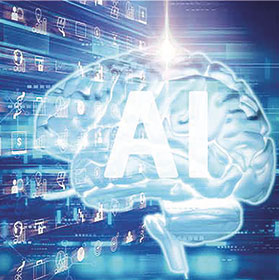

The concept of AI (artificial intelligence) has been increasingly popular in recent years, and meanwhile deep learning has triggered heated discussion. Deep learning originates from neural network algorithms and it just gets deeper and more expressive.
‘Deeper’ indicates that the algorithm evolves from two or three layers to thousands of layers and ‘expressive’ means that it can fit any mathematical function and deliver effective training. Today, deep learning has generated several frameworks including Convolutional Neural Networks, Deep Belief Networks, Recurrent Neural Networks and Deep Reinforcement Learning, which have been widely used in such fields as computer vision, speech recognition, natural language processing, audio synthesis, automatic control and bioinformatics, which results in overwhelming superiority over traditional algorithms overall.
The success of deep learning depends on a few important factors. Firstly, the improvement of computer calculation – deep learning requires a lot of calculations, which is difficult to complete for previous CPU versions, especially when GPU technology provides computing power dozens of times better than previous CPUs, making deeper and wider network training possible.
Secondly, training depth network needs a lot of data. For example, our face recognition algorithm uses more than 20 million face images for training. This was difficult to do before, but today we can collect enough training samples through the Internet. Finally, thanks to the scientists and researchers such as Yann LeCun and Hinton, they have brought about achievements on the back propagation algorithm, convolution network, Max-Pooling, ReLU, Dropout, LSTM, etc., bit by bit contributing to deep learning today.
As an open technology, the research results of deep learning are usually published in papers, pre-printed on arxiv.org, or published in the CVPR and other top conferences. Google, Facebook, Microsoft, Baidu and other enterprises all compete to participate in this trend, and they also open source on their own deep learning framework, which establishes their leadership in the field of artificial intelligence. Caffe, Torch (PyTorch), Tensor Flow, CNTK, MxNet and other frameworks have become essential tools for researchers aiming at deep learning and its application.
Our face recognition is one of the earliest algorithms that applied deep learning. In contrast to the traditional methods, deep learning of face recognition algorithms has solved the problem of recognition due to changes in facial posture, facial expression or ambient light, making face recognition in normal visual light environment a practical technology. For the analysis of face attributes, such as age and sex, etc., deep learning manifests remarkable attributes.
With the use of deep learning, palm vein recognition and iris recognition algorithms deliver more accurate results in key point detection and accuracy, as well as speed in image registration, with less noise interference. By applying deep leaning to the study of palm vein and iris texture features, more discriminatory features of the expression are to be obtained.
At present ZKTeco is carrying out the study on the deep learning of fingerprint recognition algorithms and has achieved excellent results in aspects such as the estimation of fingerprint orientation, reconstruction of low quality fingerprints, restoration of deformed fingerprints, and detection of fingerprint minutiae, etc. It is expected that with the full adoption of deep learning, fingerprint recognition algorithms will usher in a breakthrough.
Biometric technology is embracing deep learning across-the-broad, and exciting technological advances will continuously spring up. Technological progress will surely lead deep learning into more extensive realms. During this technological revolution, we are looking forward to witnessing more excellent products to bring more convenience and wonders to our life and work.
For more information, contact ZKTeco (SA), +27 (0)12 259 1047, sales@zkteco.co.za, www.zkteco.co.za

© Technews Publishing (Pty) Ltd. | All Rights Reserved.